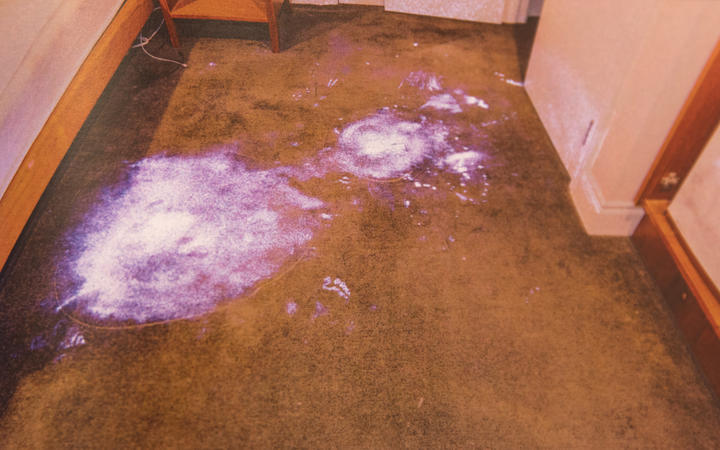Luminol testing showed bloody footprints in the room of the man accused of murdering Grace Millane, a court has heard.
 ESR scientist Dianne Crenfeldt giving evidence at the Grace Millane trial.
ESR scientist Dianne Crenfeldt giving evidence at the Grace Millane trial.
Photo:
Supplied / Pool vision / TNVZ
The 27-year-old, who cannot be named, is on trial before a jury of
seven women and five men in the High Court at Auckland this month.
It's the Crown's case he murdered Ms Millane in his CityLife
apartment after meeting for a Tinder date in Auckland's CBD last
December.
The man's defence team is arguing the British backpacker's death is
accidental after rough sex with her consent and encouragement.
ESR scientist Dianne Crenfeldt examined his apartment, where it's
agreed Ms Millane died on the night of 1 to 2 December last year.
This morning she told the jury luminol testing identified two
probable blood stains between the bed and the wardrobe; one 70cm and
another 30cm in diameter.
She said the larger stain had circular smearing within it, while the
smaller one had a more defined, circular shape, consistent with the base
of a bucket, and surrounding spots showed blood was likely dripped onto
the carpet.
The court has heard no bucket was found when police searched the apartment.
Ms Crenfeldt couldn't determine how the blood had dripped but said it
could been cast off from a body or fallen from a mop after being
diluted with water.
 A photo shown to the jury this morning of footprints revealed by luminol testing.
A photo shown to the jury this morning of footprints revealed by luminol testing.
Photo:
RNZ / Supplied
She said the staining supported a theory that a clean up had occurred
but could not say how old the blood was or when any cleaning may have
occurred.
"The shape of probable blood staining showed strong support for the
proposition that clean up of blood had occurred in this area."
The jury has heard the defendant told police he fell asleep in the
shower after having sex with Ms Millane before getting into bed to
sleep.
He said he woke up the next morning to find Ms Millane dead, and bleeding from the nose, on the floor of his bedroom.
This morning the court heard luminol testing showed blood smearing on
the carpet which indicated movement around the room when it was still
wet.
"It's the same with the footprints around the room which show
somebody with blood on their feet moved around the room and transferred
blood to these areas."
The court heard this blood wasn't visible to the naked eye but
luminol testing, which is extremely sensitive, had identified the
affected areas.
 One of the photos shown to the jury of the police scene investigation at CityLife hotel apartment.
One of the photos shown to the jury of the police scene investigation at CityLife hotel apartment.
Photo:
RNZ / Supplied
But Ms Crenfeldt said when the carpet was lifted, there was blood
visible on the underside of the carpet, as well as on the underlay and
the concrete floor.
Yesterday, the scientist said she was asked to examine an Adidas
sports bag and a black suitcase found in a wardrobe that were of
particular interest to police.
"I was advised that these bags had been seen on CCTV being removed from the building at the time of interest.
"I was also advised that the black sports bag, along with the
bedding, had been taken to a dry cleaners where it had been cleaned."
Ms Crenfeldt said there was no blood on the Adidas bag but stains were found in the carpet, on the fridge and on the suitcase.
Ms Millane's parents David and Gilliane have been in court again
today to hear the forensic evidence and cross-examination by the man's
lawyer Ian Brookie.
The trial before Justice Moore and a jury is set down for four weeks but may finish earlier.




Comments
Post a Comment